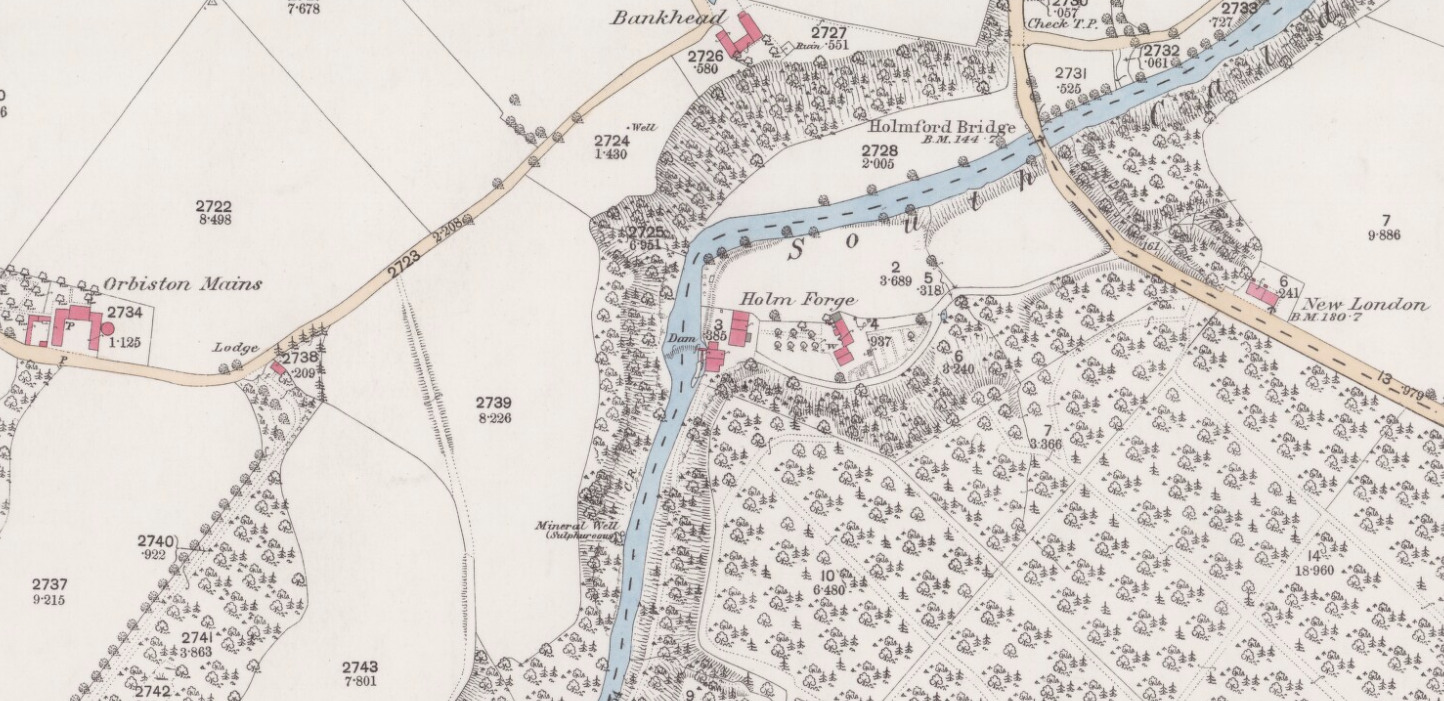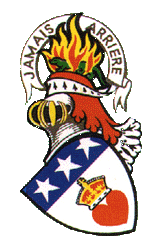|
 This house was at one time called Douglas Park, and later re-named
Orbiston. It is finely situated on the picturesque banks of the River
Calder, about midway between Bothwell and Hamilton. Douglas Park was
formerly the property of the Hamiltons of Orbiston, and was sold by
Major-General John Hamilton of Orbiston, in 1800, to
Gilbert Douglas, a West India merchant
in Glasgow, who had large plantations in the Island of St. Vincent. His
residence in the city was on the north side of George Square, now one of the
hotels. In 1794 Gilbert Douglas married Cecilia Douglas, only surviving
daughter of John Douglas, merchant in Glasgow, whose father was a merchant
in Leith, and whose mother was a daughter of the third James Dunlop of Garnkirk. Mrs. Douglas had seven brothers, one of whom was
General Sir Neil Douglas, G.C.B., a
distinguished officer; the others were West India merchants, members of the
once well known firm of John Thomas and Archibald Douglas & Co., the last
survivor of whom was the late Thomas Dunlop Douglas of Dunlop. This house was at one time called Douglas Park, and later re-named
Orbiston. It is finely situated on the picturesque banks of the River
Calder, about midway between Bothwell and Hamilton. Douglas Park was
formerly the property of the Hamiltons of Orbiston, and was sold by
Major-General John Hamilton of Orbiston, in 1800, to
Gilbert Douglas, a West India merchant
in Glasgow, who had large plantations in the Island of St. Vincent. His
residence in the city was on the north side of George Square, now one of the
hotels. In 1794 Gilbert Douglas married Cecilia Douglas, only surviving
daughter of John Douglas, merchant in Glasgow, whose father was a merchant
in Leith, and whose mother was a daughter of the third James Dunlop of Garnkirk. Mrs. Douglas had seven brothers, one of whom was
General Sir Neil Douglas, G.C.B., a
distinguished officer; the others were West India merchants, members of the
once well known firm of John Thomas and Archibald Douglas & Co., the last
survivor of whom was the late Thomas Dunlop Douglas of Dunlop.
Gilbert Douglas died in 1807 without issue, and his widow inherited his
estates of Douglas Park and Boggs, in the neighbourhood, to which she
afterwards added by purchase the remainder of the estate of Orbiston. The
properties were then merged into one, and he gave to the whole, including
the mansion house of Douglas Park, the name of Orbiston.
Orbiston, the greater part of which Mrs. Douglas acquired, was a very old
property. In ancient times it was called Urbanstoun or Osbornstoun, and
belonged to the Collegiate Church of Bothwell, and afterwards, when in
possession of a branch of the Hamilton family, it
received its present name. Hamilton of Wishaw when writing of it says, "Near
to this lyes Orbistoun, a little above where Calder falls into Clyde,
belonging to William Hamilton of Orbistoun, whose grandfather Sir John,
Justice Clerk and Lord of Session, did very much inlarge the house, planted
great gardens and woods of barren timber, with large and pleasant enclosers."
There are some remains of this old house still standing between the present
mansion house and the Calder. The family of Orbiston and Dalzell combined
afterwards held it till modern times as already shown. It was on-part of it
that Robert Owen, the son-in-law of the well known David Dale of Glasgow,
erected his singular building and attempted to carry into practice his "New
System of Society." His experiment ended in failure, and the house or houses
he erected at a cost of £12,000 were sold for £2,000, and, being taken down,
now nothing remains of them.
Mrs. Douglas survived her husband fifty-five years, and died at Douglas
Park or Orbiston House as she latterly called it, in July 1862, aged
ninety-one. She was the last survivor of the original nominees on the
Tontine buildings at the Cross, two shares being dependent on her life.
These shares afterwards came into her possession, and when all the other
nominees were dead the whole of the Tontine became her exclusive property.
The second last survivor was also a lady, Miss Speirs of Polmont Park,
daughter of Alexander Speirs, first of Elderslie. James Buchanan of Craigend,
who died shortly before Mrs. Douglas and Miss Speirs, completed a trio of
cousins who outlived by a considerable time all the other nominees.
Mrs. Douglas left a large fortune, and a fine collection of paintings and
sculptures, which she made during an extended residence in Italy. In her
will she directed her trustees to deposit this collection permanently "in
some public Institution in Scotland," and this they carried into effect by
presenting these works of art to the Corporation of Glasgow, who have
deposited them in their Galleries in Sauchiehall Street.
Mrs. Douglas further showed her interest in her native city by erecting
one of the finest of the large windows in the Cathedral of Glasgow.

THE HAMILTONS OF ORBISTON AND DALZELL.
Urbanstoun or Osbernstoun formed part of the Barony of Bothwell, and on
the lands was a chapel which was endowed by Walter Olifard, Lord of Bothwell,
with £10 yearly from the "lands of Osbernstoun."
Walter Olifard died in 1242. His granddaughter and heiress married
William de Moravia or Murray, who thus became Lord of Bothwell.
Archibald the Grim, third Earl of
Douglas, afterwards became possessed of the Barony through his marriage
with Joanna, heiress of Thomas Murray, and he gave Orbistoun as an endowment
to the Collegiate Church of Bothwell by a charter dated in 1398.
Gavin Hamilton, fourth son of Sir James Hamilton of Cadzow, was Provost
of the Collegiate Church about the middle of the fifteenth century, and,
with the consent of the Convent and Chaplains of Bothwell, granted in 1468 a
charter of Osbernstoun to his sons, of whom the third, John, seems to have
ultimately been the possessor. He was followed by his son Gavin, who was
named one of the heirs of entail in a settlement of the Hamilton estates by
the Duke of Chatelherault in 1512. Gavin's nephew, David, who lived at
Bothwelhaugh, a farm on the Orbiston estate near the Clyde, fired the shot
which killed the Regent Murray at Linlithgow in 1569. The gun which he used
was given by General Hamilton of Dalzell to the Duke of Hamilton when
Bothwelhaugh was sold to him at the beginning of this century, and is now at
Hamilton Palace.
John Hamilton of Orbieston, the next owner, was killed at the battle of
Langside in 1568.
His son, John Hamilton, had in 1604 a charter of Orbieston, Carnbroe,
Unthank, Stevenstoun, Alderstoun, Carphin, Jervistoun, &c. He died about
1621, and was succeeded by his eldest son Sir John.
This Orbiston was Lord Justice Clerk. He had charters of Provan near
Glasgow, and Erskine in Renfrewshire, the latter of which he bought from the
Earl of Mar in 1638.
On the death of Sir John's grandson William in 1703, Orbiston with the
other estates then in his possession reverted to James the grandson of Sir
John's brother James, whose mother was a daughter of Robert Dalzell of that
Ilk, and who had a charter of Dalzell in 1647.
James Hamilton's grandson having married the daughter of Sir Archibald
Hamilton of Rosehall, his son Archibald succeeded to that estate which
adjoined, as well as to Dalzell and Orbiston. Archibald's son, General John
Hamilton, sold Rosehall, and it is now called "Douglas Support." The
General's son, Archibald, served in the Peninsular War, and was in the Scots
Greys it Waterloo. He seems to have imbibed some of Mr. Robert Owen's
peculiar views, and along with others, he joined with him in establishing at
Orbiston the institution noticed above. It was General Hamilton of Dalzell
who died in 1834, aged 93, who sold Orbiston to Mrs. Cecilia Douglas. John
Glencairn Carter Hamilton, now of Dalzell, succeeded his grandfather in
1834, his father, Archibald, having died very shortly before his father the
general's death. His mother was Eleanora, eldest daughter of Daniel Hamilton
of Gilkerscleugh. Mr. Hamilton, who has represented in Parliament both the
Falkirk burghs and South Lanarkshire, is widely known in the West of
Scotland, and is one of the most useful and popular country gentlemen in
Lanarkshire.
Source: The old country houses of the old Glasgow gentry

See also:
• Plan
of the estate of Orbiston the property of General Hamilton / Surveyed by
James Knox, 1804.
|
|


